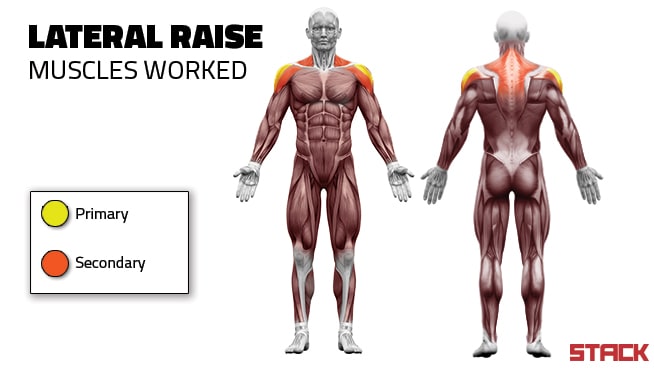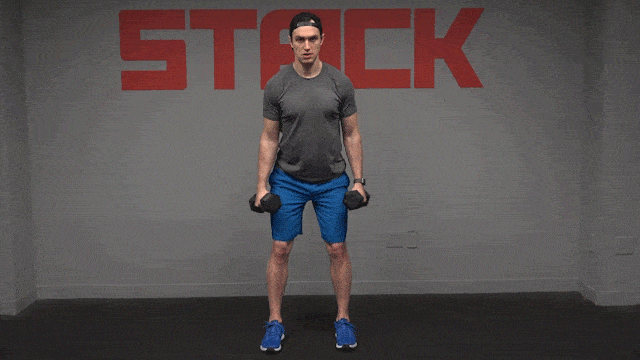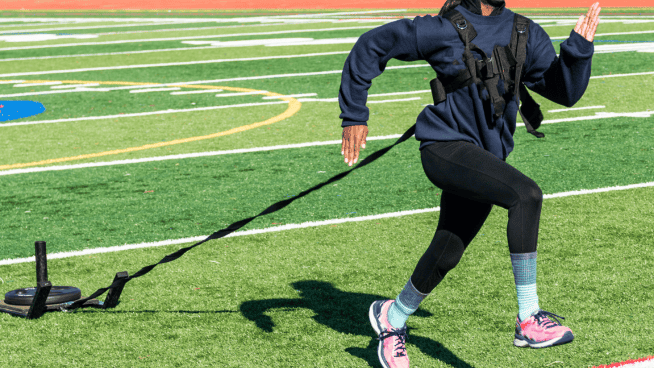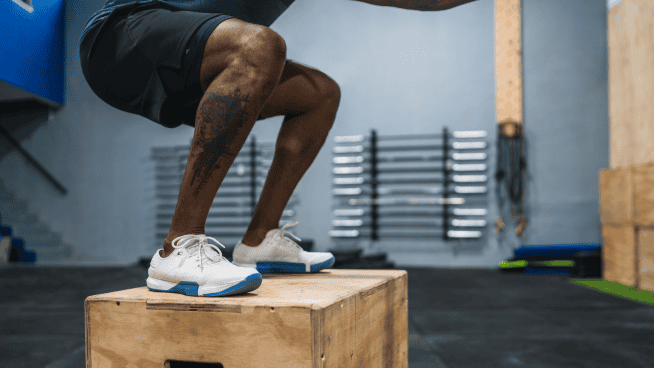Use Lateral Raises to Build Shredded Shoulders (with Variations and Form Fixes)
The Lateral Raise is a popular exercise that builds larger deltoids, which are the rounded muscles on the top of your arms at your shoulders. It’s a simple exercise to perform but it’s often performed incorrectly, resulting in shoulder discomfort or pain.
In this article, we’re going to cover everything you need to know about the Lateral Raise to build larger shoulders and perform the exercise pain-free.
- Lateral Raise Form
- Benefits of Lateral Raises
- Lateral Raise Muscles Worked
- Lateral Raise Mistakes
- Lateral Raise Alternatives and Variations
- Lateral Raise Workouts
Lateral Raise Form
Step 1: Stand with your feet hip-width apart and slightly bend your hips and knees. Hold dumbbells at your sides with your palms facing in and bend your elbows slightly.
Step 2: Tighten your core and raise the dumbbells to the side until your upper arms are no higher than shoulder height.
Step 3: Lower the dumbbells with control to return to the starting position.
Benefits of Lateral Raises
Performing the Lateral Raise builds larger deltoids and help you achieve the boulder shoulder look that many people desire. Even though it’s typically performed with a light weight, you will feel a brutal burn in your shoulders and a subsequent muscle pump that results in growth. Theoretically, having larger deltoids should help to prevent upper-body injuries by improving the muscles’ ability to absorb contact from a tackle, bodycheck or simply falling to the ground.
Lateral Raise Muscles Worked
The Lateral Raise primarily works the lateral deltoid, which is the middle portion of the deltoid muscle. The anterior (front) deltoid, posterior (back) deltoid, upper trap, supraspinatus (a rotator cuff muscle) and serratus anterior (muscles along your ribs under your armpit) also contribute to the movement.

Lateral Raise Mistakes
This is a simple exercise, but many people completely butcher it. The result is a move that looks like a Lateral Raise, but is more likely to cause shoulder pain and scare people away from the exercise. But if done correctly, it’s a safe and effective way to develop your shoulders.
Mistake 1: Lifting weights that are too heavy
This is the worst Lateral Raise mistake that people fall victim to, contributing to many of the mistakes below and causing shoulder pain. The Lateral Raise isn’t an appropriate move for building max strength with heavy weights and low reps.
Your lateral deltoid responds best to high reps, so think like a bodybuilder and stick to sets of 10 to 20 reps with a light weight to cause a muscle pump, and, as a result, muscle growth. If you’re grinding out reps, you’re doing it wrong. Every rep should be performed with perfect form and control.
Mistake 2: Bouncing up and down
Bouncing up and down is another common mistake. It usually results from using a weight that’s too heavy, similar to swaying on Curls. You might technically complete the rep, but how much are your deltoids actually working? Not as much as you’d think.
If you catch yourself bouncing, back off the weight and perform clean reps. You might not look as cool as the bros in your gym, but you’ll get more benefits from the exercise without beating up your shoulders in the process.
Mistake 3: Raising the weights too high
Do you have shoulder pain during Lateral Raises? Check how high you’re raising the dumbbells. If your upper arms are moving above parallel, you’re going too high, which, depending on your shoulder anatomy and health, may be the source of your pain. Also, this shifts much of the work to your upper traps and away from the lateral deltoids, which defeats the purpose of the exercise.
Mistake 4: Gripping the dumbbells too tight
Traditionally, you’re taught to grip weights as tightly as you can, which increases muscle activation, improves shoulder stability and makes you stronger on a lift. However, Dr. John Rusin, strength coach, physical therapist and owner of John Rusin Fitness Systems, explains this shifts the work away from the lateral deltoid to larger upper-body muscles. Instead, he recommends holding the dumbbells with a light grip to more effectively engage the lateral deltoids.
Lateral Raise Alternatives and Variations
There are many variations of the Lateral Raise that provide a slightly different challenge for your shoulders.
Scaption Raise
If you find that Lateral Raises consistently cause pain, shift your arms forward at a 30-degree angle. This places your shoulders in a slightly more joint-friendly position that allows your shoulder blades to move more freely.
Band Raises
Swap out dumbbells for resistance bands, which will challenge your lateral delts through the full range of motion via accommodating resistance.
Seated Raises
Sitting down limits your ability to bounce if you’re having trouble ditching that habit (more on this below). Also, this can be swapped for traditional Lateral Raises to add variety to your workouts.
Partial Reps
Strength coach Dean Somerset recommends performing partial reps if you experience shoulder pain, which means that you perform each rep only about halfway up. This should eliminate any discomfort from the exercise while still training your lateral delts.
No discussion of Lateral Raise variations is complete without mentioning Front Raises, which target the anterior deltoid, and Rear Delt Raises, which target the posterior deltoid. Many people have weak posterior deltoids, so the Rear Delt Raise should be a major focus in most training programs.
Lateral Raise Workouts
Here are a few workout options that feature Lateral Raises:
Lateral Raise-Only Workout
-
Dumbbell Lateral Raises – 4×15-20
3-Way Raise Circuit
Perform these exercises one after the other in a circuit without resting between them.
-
Dumbbell Lateral Raises – 3×6
-
Dumbbell Front Raises – 3×6
-
Dumbbell Rear Delt Raise – 3×6
Shoulder Burnout Workout
-
Overhead Press – 3×10
-
Lateral Raises – 3×10
-
Band Pull-Aparts – 3×20
RELATED:
RECOMMENDED FOR YOU
MOST POPULAR
Use Lateral Raises to Build Shredded Shoulders (with Variations and Form Fixes)
The Lateral Raise is a popular exercise that builds larger deltoids, which are the rounded muscles on the top of your arms at your shoulders. It’s a simple exercise to perform but it’s often performed incorrectly, resulting in shoulder discomfort or pain.
In this article, we’re going to cover everything you need to know about the Lateral Raise to build larger shoulders and perform the exercise pain-free.
- Lateral Raise Form
- Benefits of Lateral Raises
- Lateral Raise Muscles Worked
- Lateral Raise Mistakes
- Lateral Raise Alternatives and Variations
- Lateral Raise Workouts
Lateral Raise Form
Step 1: Stand with your feet hip-width apart and slightly bend your hips and knees. Hold dumbbells at your sides with your palms facing in and bend your elbows slightly.
Step 2: Tighten your core and raise the dumbbells to the side until your upper arms are no higher than shoulder height.
Step 3: Lower the dumbbells with control to return to the starting position.
Benefits of Lateral Raises
Performing the Lateral Raise builds larger deltoids and help you achieve the boulder shoulder look that many people desire. Even though it’s typically performed with a light weight, you will feel a brutal burn in your shoulders and a subsequent muscle pump that results in growth. Theoretically, having larger deltoids should help to prevent upper-body injuries by improving the muscles’ ability to absorb contact from a tackle, bodycheck or simply falling to the ground.
Lateral Raise Muscles Worked
The Lateral Raise primarily works the lateral deltoid, which is the middle portion of the deltoid muscle. The anterior (front) deltoid, posterior (back) deltoid, upper trap, supraspinatus (a rotator cuff muscle) and serratus anterior (muscles along your ribs under your armpit) also contribute to the movement.

Lateral Raise Mistakes
This is a simple exercise, but many people completely butcher it. The result is a move that looks like a Lateral Raise, but is more likely to cause shoulder pain and scare people away from the exercise. But if done correctly, it’s a safe and effective way to develop your shoulders.
Mistake 1: Lifting weights that are too heavy
This is the worst Lateral Raise mistake that people fall victim to, contributing to many of the mistakes below and causing shoulder pain. The Lateral Raise isn’t an appropriate move for building max strength with heavy weights and low reps.
Your lateral deltoid responds best to high reps, so think like a bodybuilder and stick to sets of 10 to 20 reps with a light weight to cause a muscle pump, and, as a result, muscle growth. If you’re grinding out reps, you’re doing it wrong. Every rep should be performed with perfect form and control.
Mistake 2: Bouncing up and down
Bouncing up and down is another common mistake. It usually results from using a weight that’s too heavy, similar to swaying on Curls. You might technically complete the rep, but how much are your deltoids actually working? Not as much as you’d think.
If you catch yourself bouncing, back off the weight and perform clean reps. You might not look as cool as the bros in your gym, but you’ll get more benefits from the exercise without beating up your shoulders in the process.
Mistake 3: Raising the weights too high
Do you have shoulder pain during Lateral Raises? Check how high you’re raising the dumbbells. If your upper arms are moving above parallel, you’re going too high, which, depending on your shoulder anatomy and health, may be the source of your pain. Also, this shifts much of the work to your upper traps and away from the lateral deltoids, which defeats the purpose of the exercise.
Mistake 4: Gripping the dumbbells too tight
Traditionally, you’re taught to grip weights as tightly as you can, which increases muscle activation, improves shoulder stability and makes you stronger on a lift. However, Dr. John Rusin, strength coach, physical therapist and owner of John Rusin Fitness Systems, explains this shifts the work away from the lateral deltoid to larger upper-body muscles. Instead, he recommends holding the dumbbells with a light grip to more effectively engage the lateral deltoids.
Lateral Raise Alternatives and Variations
There are many variations of the Lateral Raise that provide a slightly different challenge for your shoulders.
Scaption Raise
If you find that Lateral Raises consistently cause pain, shift your arms forward at a 30-degree angle. This places your shoulders in a slightly more joint-friendly position that allows your shoulder blades to move more freely.
Band Raises
Swap out dumbbells for resistance bands, which will challenge your lateral delts through the full range of motion via accommodating resistance.
Seated Raises
Sitting down limits your ability to bounce if you’re having trouble ditching that habit (more on this below). Also, this can be swapped for traditional Lateral Raises to add variety to your workouts.
Partial Reps
Strength coach Dean Somerset recommends performing partial reps if you experience shoulder pain, which means that you perform each rep only about halfway up. This should eliminate any discomfort from the exercise while still training your lateral delts.
No discussion of Lateral Raise variations is complete without mentioning Front Raises, which target the anterior deltoid, and Rear Delt Raises, which target the posterior deltoid. Many people have weak posterior deltoids, so the Rear Delt Raise should be a major focus in most training programs.
Lateral Raise Workouts
Here are a few workout options that feature Lateral Raises:
Lateral Raise-Only Workout
-
Dumbbell Lateral Raises – 4×15-20
3-Way Raise Circuit
Perform these exercises one after the other in a circuit without resting between them.
-
Dumbbell Lateral Raises – 3×6
-
Dumbbell Front Raises – 3×6
-
Dumbbell Rear Delt Raise – 3×6
Shoulder Burnout Workout
-
Overhead Press – 3×10
-
Lateral Raises – 3×10
-
Band Pull-Aparts – 3×20











